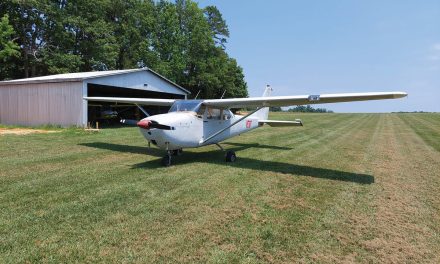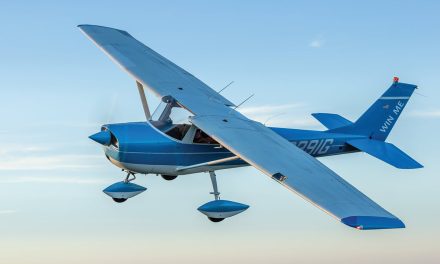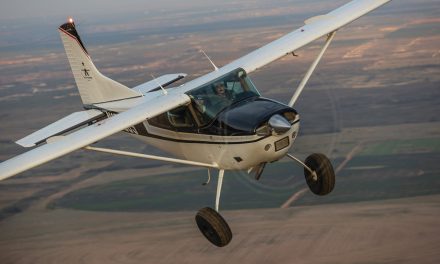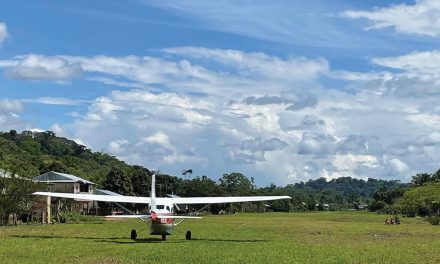Never mind the realities of aircraft production and a fickle marketplace; wouldn’t it have been nice if Cessna had built some of these?
It doesn’t sound that different sitting on the ramp. The engine starts pretty much the same, though there is a fuel pump aboard, missing from the stock machine. Taxi and run-up are relatively uneventful, and the takeoff checklist isn’t that different from that of the stock airplane.
Only when you taxi out onto the runway and push the power up do you begin to notice the difference. Whereas most stock 150s have the acceleration of an ice cream truck, this airplane delivers considerably more power to your right hand.
Suddenly you realize that things are happening much quicker than in a stock 150. The airplane gathers itself quickly, steps into the air in minimum runway and starts uphill as if something bigger is chasing it. This is more like it, you muse. Now, this is what a TRAINER should be.
Or is it? You’re tempted to wonder if a new student, taking his first tentative steps into the sky, might be a little overwhelmed by so much enthusiasm out front. If you’re planning to teach someone to drive, you probably wouldn’t start them off in a Shelby Mustang or Corvette, would you?
OK, the Cessna 150/150 isn’t quite that spectacular, but it is worlds ahead of the standard Cessna 150 Commuter that so many pilots interned in. Cessna obviously got most everything right on the 150/152, even if some of the current mods improve on a good thing. The stock airplane is a manifesto of moderation – nothing happens faster than a student pilot can think about it.
The airplane I fly today is a very different version of the little Cessna that half of most general aviation pilots trained in. This one was the product of a bored airline pilot and has become the province of a dentist with a flair for something different.
Just over a year ago, Dr. Peter Spennato of Rolling Hills, California, purchased the airplane from a retired airline captain in Ft. Lauderdale, Florida. He then had it ferried out to California and embarked on a refurbishment of his own, fixing everything in sight—and some things out of sight.
He started with a 150 that was already a major cut above any two-seat, Cessna nose dragger. When he was finished, he wound up with what could be one of the most modified 150s above the planet. It’s an airplane that performs like a 172 with only two seats up front.
Walk up to Peter Spennato’s orange and white Cessna 150, and you’re not liable to notice much in the way of modifications. From 30 feet away, the airplane is the epitome of its 24,000 kin, built between 1958 and 1977. (At the peak of production in 1966, Cessna produced just over 3000 Cessna 150s in a single year. That’s about 1.5 airplanes per working hour.) If Spennato’s Cessna resembles time standing still on the outside, the interior is totally up-to-date. Look inside, and it becomes obvious this isn’t your grandfather’s trainer.
What began life as a 1967 Cessna 150G Commuter has been transformed into an enthusiastic Super Commuter capable of leaping the tallest mountains in the southern 48 states. In addition to the 150-hp Lycoming O-320E2D powerplant, there’s a first-class Corinthian leather interior plus shoulder harnesses. The panel boasts a Garmin 530 and 420 plus a 327 transponder and a 340 audio panel. There’s also a Goodrich Stormscope, though it’s hard to imagine anyone using a 150 with any amount of horsepower to navigate around thunderstorms. Fuel flow and engine analysis are handled by a JPI EDM-800 system. Finally, the panel sports a Zaon TCAS system.
Out on the wings, the airplane is fitted with a full Horton STOL kit including flaps that deflect to 50 degrees and flaperons that droop during the last 30 degrees of travel. Fuel capacity has been increased from 23 to 40 gallons.
Perhaps ironically, the 150-hp Lycoming engine is one of the least apparent improvements. Though the airplane is 50 percent more powerful than its original configuration, the difference isn’t visually that noticeable. The cowling is a little different if you look closely, but Spennato’s Cessna maintains its delicate stance on the ramp. It’s something of a sleeper that will stun most other 150 pilots and even a few 172 drivers in takeoff and climb performance.
Short field performance and climb are the most obvious beneficiaries of extra power. Equipped with a Sensenich 74-53 prop, the airplane can turn in 1000 fpm consistently from sea level with a full load. The 53-inch pitch is fairly standard and favors climb over cruise, but if you’re looking for slightly more speed, some pilots choose the 56-inch twist.
The combination of copious power and a bigger prop effectively solves what was always a major problem with most original 150s—they’re just not that strong operating out of Albuquerque, Denver, or El Paso in the dog days of summer. In fact, most flight schools wouldn’t consider flying them with a student and instructor at density altitudes above about 4000 feet.
Performance is decidedly impressive with 50 percent more power on the nose. Push the left knob full forward, and the Super 150 leaves town as if it’s being shot at. Even at full gross, you can catapult into the sky in a few hundred feet and climb away at 1000 fpm. An even nicer feature is that the airplane retains reasonable climb at higher altitudes. It’s definitely encouraging to be able to lift the nose for climb at 6500 feet and still see 500 fpm up on the VSI.
Adding power has never been an efficient method of improving cruise speed. On Spennato’s Super 150, it boosts max cruise at 7500 feet to about 113 knots. Depending upon who you ask, that’s a 10-knot improvement over a stock airplane, and it pushes the modified 150 along at about the same speed as an early Skyhawk.
The obvious penalty for the privilege of quicker locomotion is higher fuel burn. You can expect to cycle 8.0-8.5 gph through the Lycoming instead of 5.5 gph with the stock Continental O-200. If you’re feeling frugal, you can throttle back to 65 percent and score 107 knots on a gallon less per hour, but I’d bet most pilots will leave the throttle against the forward stop above 7500 feet. The O-320 seems to thrive on high rpm, and you’re not running it above 75 percent anyway.
Landings give you all the benefits of the big Cessna wing and the power to recover from any inadvertent stall at low altitude. Stall speed remains the same as does gross weight (though there is an STC that raises the gross by 150 pounds). That means you can fly the pattern at the same 60 knots you’d use in the stock airplane and expect the stall to pay off at about the same speed and with similar characteristics.
One thing you can’t do with the big engine installed is spin the airplane. That’s not approved with anything other than the stock powerplant. There is an STC that allows the 150-hp conversion on the Cessna Aerobat, and I can’t help wondering if there are any limitations on acro maneuvers in that airplane. You’d think more power could only do good things for an aerobatic airplane.
Another obvious downside of the extra power is the inevitable domino effect of a larger engine. Unless you’re switching from piston to turboprop power (that can double the horsepower for half the weight – no one has tried that on a 150), a more powerful engine is almost bound to add weight. That, in turn, subtracts from useful load. In order to preserve some semblance of range, you’ll probably need to increase fuel capacity, and that will automatically subtract from cabin payload.
In the case of the 150/150, topping the 40-gallon tanks typically leaves a weight allowance of one person in the cabin. Full fuel endurance is nearly four hours which translates to well over 400 nm between fuel stops. In Spennato’s airplane, you can fly with two folks only if you leave most of the fuel in the truck.
Many years ago, I was in Kenai, Alaska, waiting for a ferry airplane to get ready, and was offered the chance to fly a 180-hp Cessna 150 that had been converted to a tailwheel. The owner also owned the FBO where my Mooney 252 was being prepared, and he demonstrated some amazing things to me during that two-day delay, tricks like landing on water with huge balloon tires and water taxiing to a sandbar before dropping the tail.
The following morning as I was getting a weather briefing for my trip south, the FAA briefer asked if I was the guy flying with Doug in the modified 150 the day before. I said yes, and he smiled and said, “There’s nothing on that airplane that was approved. We made a deal with Doug that if he didn’t wreck it and we never had to fill out any paperwork, we wouldn’t give him any trouble.”
Dr. Spennato’s airplane is totally legal. In fact, he purchased his 150/150 specifically so his son, Stephen, could learn to fly. Stephen is a relatively lightweight pilot, perhaps 140 pounds after a big lunch. Fortunately, his instructor is also only a middleweight, so Stephen earned his Private Pilot license at the end of 2014 at the age of seventeen. (If only I could start over at the same age…)
Back in 1967, a stock 150G went out the door at $9500 with typical equipment. Today, the same, well-kept, used airplane sells for $14,500, according to the Winter 2014 edition of Aircraft Bluebook Price Digest. There’s no telling what you’d pay for a 150 upgraded to 150 hp, but a quick survey of the market suggests an airplane such as Spennato’s, with its long avionics list, leather interior, and copious other options might bring $30,000.
As mentioned above, there are other upgrades you can perform on a 150/152. Some, like my Alaska friend, have mounted a 180-hp Lycoming up front, apparently on the premise that given enough power, you could push the little Cessna through the Mach. Others have converted to the Texas Taildragger configuration, relocating the steering wheel to the rear. Some bush aviators have installed gap seals and vortex generators to reduce stall even slower than the stock 43 knots.
In both the older and younger Spennatos’ case, the goal is mostly fun, and the Cessna 150/150 provides plenty of that.





